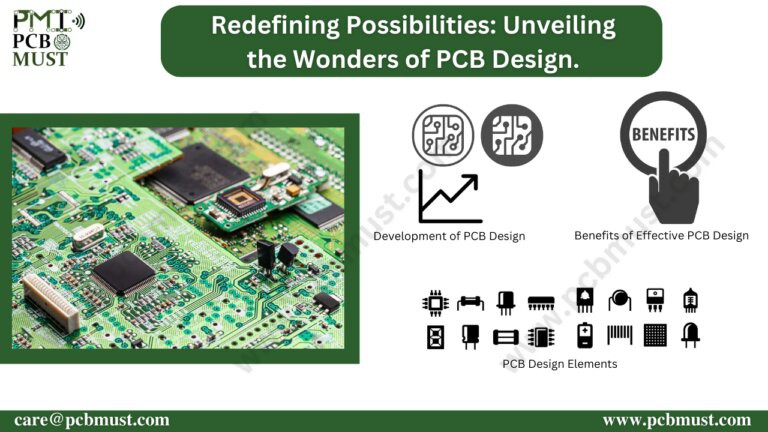Modern engineering and innovation heavily rely on printed circuit board design, or PCB design. It offers the framework for the development and use of electronic devices and systems. PCB design is the process of laying out and organizing electronic components on a board, as well as providing mechanical support and electrical connections. The complexity of electrical devices and the constant development of technology have increased the demand for efficient and effective PCB design. This article examines the value of PCB design in engineering innovation while also outlining its key benefits and characteristics.

The Development of PCB Design
PCB design has come a long way since it initially started in the middle of the 20th century. Early systems required labor-intensive point-to-point assembly or manual wiring to link the components. These designs were usually lengthy, clumsy, and prone to errors. However, the design process was streamlined and made more efficient as printed circuit board technology improved.
With the advent of automated PCB design tools in the 1970s, the industry underwent a revolution. Computer-aided design (CAD) tools allowed engineers to develop and refine PCB layouts more rapidly and accurately. As a result, PCB stability and functionality increased, and electrical device miniaturization made tremendous progress.
These days, PCB design tools come with a huge range of features and capabilities. Using cutting-edge software, designers may create intricate designs with multiple layers, fast traces, and interconnected components. These technologies also allow for simulations and testing, which confirm the dependability and performance of the design before it is manufactured.
Important PCB Design Elements
A number of crucial components that are part of PCB design are essential to the success of engineering innovation. Placement of components, routing, signal integrity, power distribution, and manufacturability are a few of these.
Electronic components are placed on circuit boards in a certain order to maximize usefulness, reduce noise, and enable effective routing. Achieving signal integrity and minimizing electromagnetic interference (EMI) depend on proper placement. Modern PCB design software provides automated component placement algorithms that provide layout optimization depending on particular needs.
Routing is the process of employing conductive traces to establish electrical connections between components. Achieving effective routing guarantees signal integrity, reduces EMI, and permits effective power distribution. Automated routing is a feature of advanced PCB design software that takes impedance management, trace length matching, and high-speed signal integrity into account.
Signal integrity is crucial when designing PCBs, especially for high-frequency applications. Engineers must carefully consider factors including signal degradation, reflections, and crosstalk in order to ensure accurate and reliable signal transmission. By using simulation tools to investigate and address signal integrity issues throughout the design phase, time and money are saved.
Power distribution is a crucial factor to take into account while designing PCBs. Effective power transmission and control are essential for electronic device reliability. The placement of ground strategically increased performance.
Manufacturability issues are crucial in ensuring that the planned PCB can be fabricated and integrated successfully. Design for manufacturing (DFM) standards, board size, layer stack-up, and component availability are some of the factors that designers must take into account. By keeping these aspects in mind throughout the design phase, PCB yield and dependability can be improved while production costs can be decreased.
Benefits of Effective PCB Design
Effective PCB design has a significant positive impact on engineering innovation. It enables the development of incredibly compact, lightweight, and functioning electrical gadgets. Through component placement optimization and the use of cutting-edge routing techniques, engineers may decrease the size and weight of PCBs while increasing their performance and dependability.
Another advantage of effective PCB design is that it can cut down on costs and development time. By using simulation and testing tools, engineers can identify and correct design defects early in the development cycle, avoiding costly design iterations and prototyping. This expedites the launch of new products and gives companies a competitive edge over rivals.
Well-designed PCBs also result in improved signal integrity and reduced electromagnetic interference (EMI). Because of this, systems operate more effectively, allowing for faster data transfer rates and fewer mistakes. In applications such as telecommunications, medical equipment, and aircraft, accurate and dependable signal transmission is crucial, and effective PCB design is critical to satisfying these requirements.
Electrical systems can also be flexible and expandable thanks to PCB design. By designing PCBs with expansion slots, connector interfaces, and standard form factors, engineers may easily upgrade or replace components, facilitating future improvements or repairs. This adaptability is especially useful in industries where it is common practice to update products and implement new technologies.
Conclusion
The PCB design industry drives innovation in modern engineering. Its advancement has had a significant impact on the design and functioning of electrical devices. By focusing on elements like component positioning, routing, signal integrity, power distribution, and manufacturability, engineers can create reliable and efficient PCB designs. Effective PCB design has many benefits, including compactness, increased performance, faster development times, cheaper costs, greater signal integrity, and scalability. As technology advances, PCB design will continue to be crucial for promoting technical innovation and enlarging the range of what is practicable in the realm of electronics.
PCB design is the key to engineering innovation. Its impact on product development, performance improvement, and technical advancement as a whole cannot be overstated. PCB designers push the boundaries of what is practical by cramming a lot of components into small boards, enhancing the performance and dependability of electrical systems, enabling speedy prototyping and iterative design processes, and promoting collaboration across varied teams.
About the Author:
Avi Gupta, Founder of PCB Must Innovations, is a dynamic force in the world of electronics design. With a wealth of industry experience, Avi thrives on solving intricate problems and delivering dependable solutions. A tech enthusiast, Avi stays ahead of trends while cherishing precious moments with family.
Avi could be reached at care@pcbmust.com
 Avi Gupta
Avi Gupta
Discussions
Become a Hackaday.io Member
Create an account to leave a comment. Already have an account? Log In.